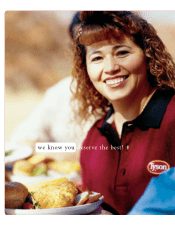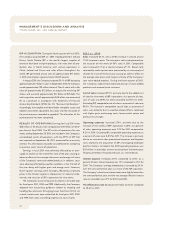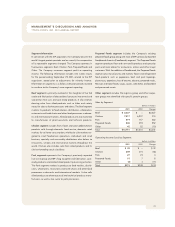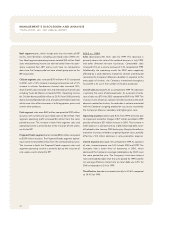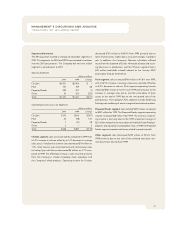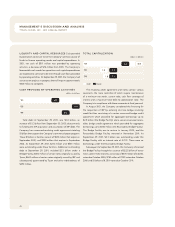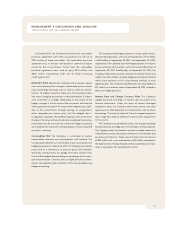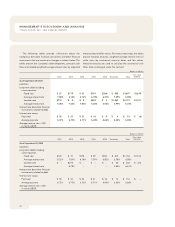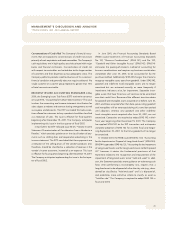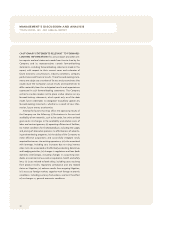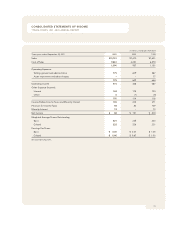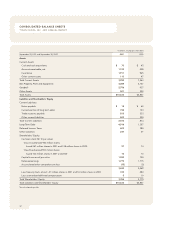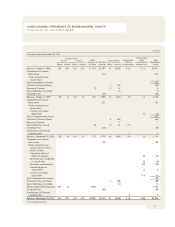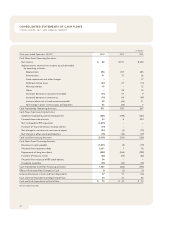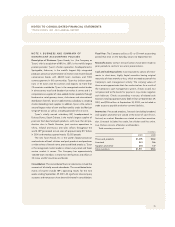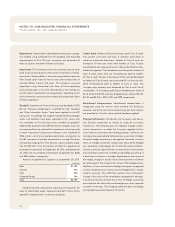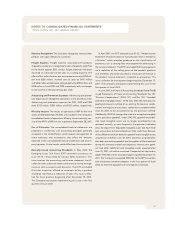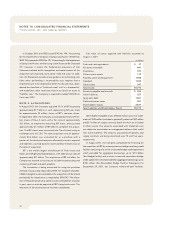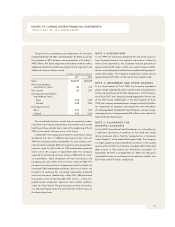Tyson Foods 2001 Annual Report Download - page 31
Download and view the complete annual report
Please find page 31 of the 2001 Tyson Foods annual report below. You can navigate through the pages in the report by either clicking on the pages listed below, or by using the keyword search tool below to find specific information within the annual report.
29
MANAGEMENT
’S DISCUSSION AND ANALYSIS
TYSON FOODS, INC. 2001 ANNUAL REPORT
Concentrations of Credit Risk The Company’s financial instru-
ments that are exposed to concentrations of credit risk consist
primarily of cash equivalents and trade receivables. The Company’s
cash equivalents are in high quality securities placed with major
banks and financial institutions. Concentrations of credit risk
with respect to receivables are limited due to the large number
of customers and their dispersion across geographic areas. The
Company performs periodic credit evaluations of its customers’
financial condition and generally does not require collateral. No
single customer or customer group represents greater than 10%
of total accounts receivable.
RECENTLY ISSUED ACCOUNTING STANDARDS In May
2000, the Emerging Issues Task Force (EITF) reached a consensus
on Issue 00-14, “Accounting for Certain Sales Incentives
.”
This issue
involves the accounting and income statement classification for
sales subject to rebates and revenue sharing arrangements as well
as coupons and discounts. The EITF concluded that sales incen-
tives offered to customers to buy a product should be classified
as a reduction of sales. This issue is effective for fiscal quarters
beginning after December 15, 2001. The Company anticipates
implementing this issue in the first quarter of fiscal 2002.
In April 2001, the EITF released Issue 00-25, “Vendor Income
Statement Characterization of Consideration from a Vendor to a
Retailer,” which provides guidance on the classification of pay-
ments such as slotting fees and cooperative advertising in the
income statement. The EITF concluded that these payments are
a reduction of the selling prices of the vendor’s products and,
therefore, should be classified as a reduction of revenue in the
vendor’s income statement, instead of as an expense. This issue
is effective for fiscal quarters beginning after December 15, 2001.
The Company anticipates implementing this issue in the first quar-
ter of fiscal 2002.
In June 2001, the Financial Accounting Standards Board
(FASB) issued Statements of Financial Accounting Standards
No. 141, “Business Combinations” (SFAS 141), and No. 142,
“Goodwill and Other Intangible Assets” (SFAS 142). SFAS 141
eliminates the pooling-of-interests method of accounting for
business combinations and requires any business combination
completed after June 30, 2001, to be accounted for by the
purchase method. Additionally, SFAS141 changes the criteria to
recognize intangible assets apart from goodwill. Under SFAS 142,
goodwill and indefinite lived intangible assets are no longer
amortized but are reviewed annually, or more frequently if
impairment indicators arise, for impairment. Separable intan-
gible assets that have finite lives will continue to be amortized
over their useful lives. Because of the different transition dates
for goodwill and intangible assets acquired on or before June 30,
2001, and those acquired after that date, pre-existing goodwill
and intangibles will be amortized during this transition period
until adoption, whereas new goodwill and other indefinite
lived intangible assets acquired after June 30, 2001, are not
amortized. Companies are required to adopt SFAS 142 in their
fiscal year beginning after December 15, 2001. The Company
has applied SFAS 142 to the IBP transaction and anticipates
complete adoption of SFAS 142 for its 2002 fiscal year begin-
ning September 30, 2001. At that time goodwill will no longer
be amortized.
In October 2001, the FASB issued SFAS No. 144, “Accounting
for the Impairment or Disposal of Long-Lived Assets” (SFAS 144).
SFAS 144 supersedes SFAS No.121, “Accounting for the Impairment
of Long-Lived Assets and for Long-Lived Assets to Be Disposed
Of;” however, it retains the fundamental provisions of that
Statement related to the recognition and measurement of the
impairment of long-lived assets to be “held and used.” In addi-
tion, the Statement provides more guidance on estimating cash
flows when performing a recoverability test, requires that a
long-lived asset to be disposed of other than by sale (e.g., aban-
doned) be classified as “held and used” until it is disposed of,
and establishes more restrictive criteria to classify an asset as
“held for sale.” The Company is required to adopt SFAS 144 in
fiscal year 2003.



